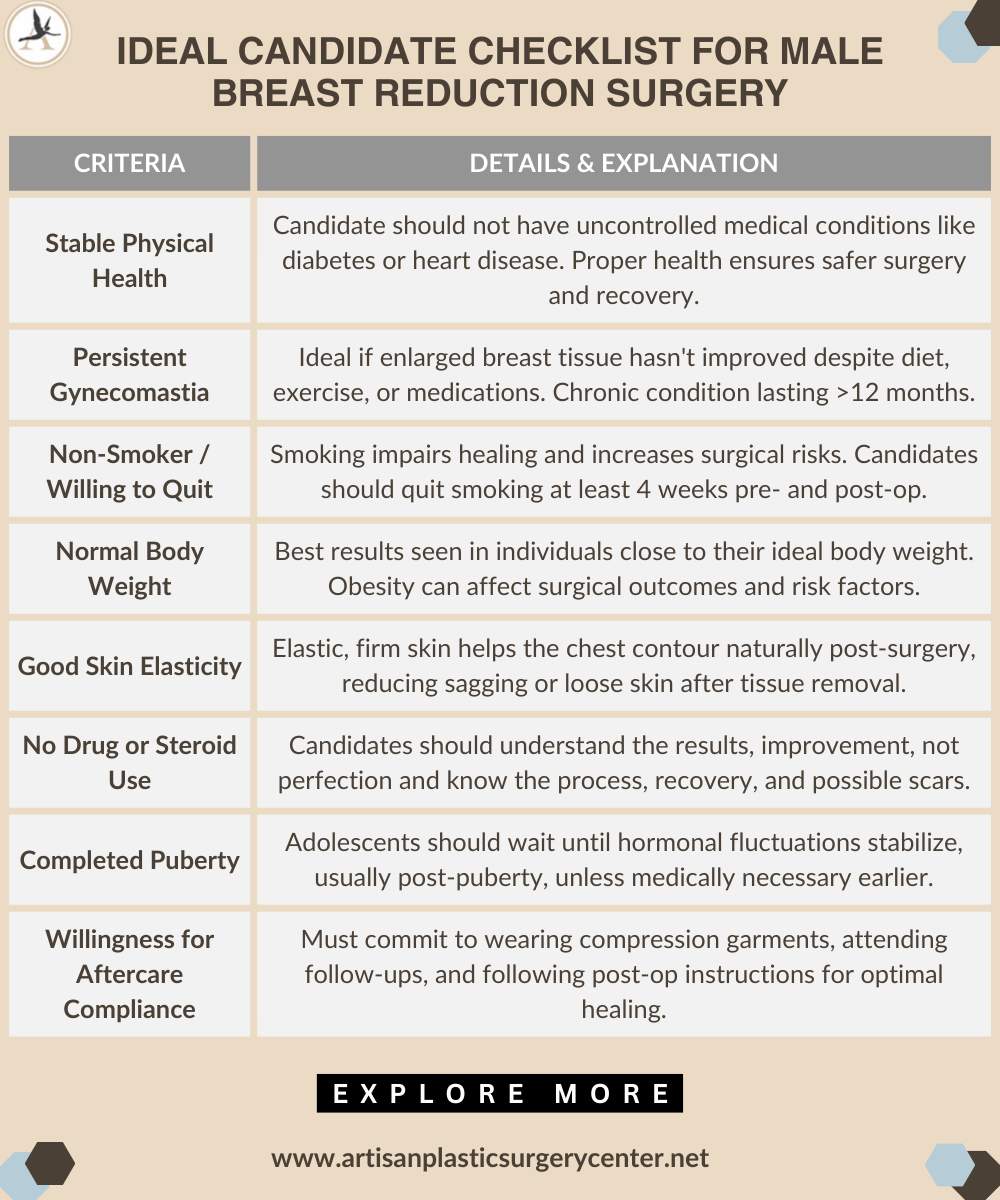In recent years, there has been more discussion about male breast reduction mammoplasty (gynecomastia surgery). Moreover, the condition can cause physical discomfort and emotional distress, impacting self-esteem and quality of life. Although it is often considered a cosmetic issue. But many factors, such as hormonal imbalances, genetics, and lifestyle choices overall, contribute to the condition. Furthermore, as society becomes more accepting of male body image, many men are seeking solutions for gynecomastia. To regain confidence and achieve a more masculine physique. Therefore, this blog post explores male breast reduction in Tampa, its causes, and treatment options. Including the psychological benefits of male breast reduction surgery.
Male Breast Reduction Mammoplasty – The Key Takeaways
Gynecomastia is a condition where males experience enlargement of breast tissue. This issue affects many men and can impact both physical health and self-esteem. Addressing gynecomastia is important for overall well-being. One effective treatment is male breast reduction surgery.
- Gynecomastia is a common condition that can significantly impact both physical and psychological well-being.
- Thus, it’s essential for individuals experiencing symptoms to consult with qualified healthcare professionals to determine the best course of action.
- Addressing gynecomastia through appropriate treatment options. Such as non-surgical treatments like lifestyle changes or medications. Also, surgical intervention can lead to improved self-esteem and quality of life.
What is Gynecomastia?
To illustrate, gynecomastia involves the growth of glandular breast tissue in males. This isn’t the same as having extra fat due to weight gain. However, several factors can lead to this condition:
- Health Conditions: Issues such as liver disease, kidney failure, or tumors can also be caused.
- Substance Use: Alcohol, marijuana, and anabolic steroids have been linked to this condition.
- Medications: Some drugs, such as certain antibiotics, heart medicines, and ulcer treatments, can cause gynecomastia.
- Hormonal Imbalances: An imbalance between estrogen and testosterone can cause breast tissue to grow. This is common during puberty and in older age.
Studies have found that about 36% of younger adult men and 57% of older men have palpable breast tissue.
Male Breast Reduction Mammoplasty – Gynecomastia Types, Symptoms, and Diagnosis
Types
To point out, the following types can offer at different stages of life:
- Neonatal: Affects 60% to 90% of infants due to maternal hormones.
- Puberty: Up to 70% of boys may experience this during adolescence, often resolving on its own.
- Older Age: Common in men over 50 due to testosterone levels and hormonal changes.
- Pathological Gynecomastia: Results from underlying health issues or medication side effects.
Symptoms
To demonstrate, the common signs include:
- Nipple sensitivity.
- Swollen breast tissue.
- Tenderness or pain in the breasts.
Diagnosis
To diagnose gynecomastia, surgeons may:
- Review medical history.
- Perform a physical exam.
- Order tests like blood work or imaging studies.

Male Breast Reduction Mammoplasty – The Gynecomastia Psychological Impact
1. Emotional Effects
Men with gynecomastia often face:
- Body image issues.
- Lowered self-esteem.
- Feelings of embarrassment.
2. Social Consequences
Eventually, the condition can lead to:
- Strained intimate relationships.
- Increased risk of anxiety and depression.
- Avoidance of social situations like swimming.
Male Breast Reduction Mammoplasty – Gynecomastia Treatment Options
According to Statista’s report, in 2023, there were 21,043 male breast reduction surgeries in the U.S., making it one of the top procedures for men.
1. Non-Surgical Treatments
- Medications: Some drugs can adjust hormone levels, but their effectiveness varies.
- Lifestyle Changes: Eating a balanced diet and exercising can help, especially if the gynecomastia is related to weight gain.
2. Surgical Treatments
This surgery removes excess breast tissue and fat. For instance:
- Liposuction: This removes fat deposits.
- Excision: Cuts out glandular tissue and excess skin.
Sometimes, both methods are combined for the best results.
Male Breast Reduction Mammoplasty – Ideal Candidates for Gynecomastia
Suitable candidates are:
- Men with stabilized breast development.
- Healthy individuals without serious illnesses.
- Those who feel discomfort or self-consciousness about their chest appearance.
Recovery Process After Surgery
- Most can return to work within a week.
- Swelling and bruising are common initially.
- Patients may need to wear compression garments.
- Strenuous activities should be avoided for a few weeks.

Male Breast Reduction Mammoplasty – Integrating Lifestyle Changes Post-Gynecomastia
1. Importance of Diet and Exercise
Unquestionably, maintaining a healthy lifestyle post-surgery is vital to prevent the recurrence of gynecomastia. A balanced diet rich in fruits, vegetables, lean proteins, and whole grains supports overall health and weight management.
Regular exercise, combining cardiovascular activities with strength training, helps maintain a healthy weight and promotes hormonal balance. Furthermore, avoiding substances like alcohol and anabolic steroids is also crucial. Because they can contribute to hormonal imbalances, leading to gynecomastia.
2. Recommended Products
Incorporating certain nutritional supplements can support weight management and overall health:
- Vitamin D: Essential for bone health and immune function.
- Protein Supplements: Aid in muscle recovery and growth, especially when combined with exercise.
- Omega-3 Fatty Acids: Found in fish oil supplements, they support heart health and reduce inflammation.
Before starting any supplement regimen, consult with a healthcare professional to ensure it’s appropriate for your individual health needs.
Male Breast Reduction Mammoplasty – Popular Gynecomastia FAQs
What Is the Cost of Male Breast Reduction Surgery?
The cost of male breast reduction surgery varies based on several factors, including the surgeon’s experience, geographic location, and the complexity of the procedure. On average, the cost ranges from $3,000 to over $8,000.
For instance, the American Society of Plastic Surgeons (ASPS) reported an average cost of $5,587 for gynecomastia surgery. However, this figure may not include additional expenses such as anesthesia, operating room facilities, or other related costs. It’s essential to discuss the total estimated cost with your surgeon during the consultation.
How Long Does it Take to Recover from Gynecomastia Surgery?
Recovery time can vary depending on the individual and the extent of the surgery. Generally, patients can expect the following timeline:
- First Few Days: Mild discomfort, swelling, and bruising are common. Pain can typically be managed with prescribed medications.
- 1 to 2 Weeks: Many patients return to work and light activities. However, it’s advisable to avoid strenuous exercise.
- 3 to 4 Weeks: Most swelling subsides, and patients can gradually resume more vigorous physical activities, following their surgeon’s guidance.
Adhering to post-operative care instructions, such as wearing compression garments and attending follow-up appointments, can promote a smoother recovery.
Are There Any Risks Associated with Gynecomastia?
As with any surgical procedure, male breast reduction carries potential risks, including:
- Infection: Proper wound care and antibiotics can mitigate this risk.
- Scarring: While surgeons aim to minimize scars, some scarring is inevitable.
- Asymmetry: There might be slight differences between the two sides of the chest post-surgery.
- Changes in Nipple Sensation: Some patients may experience temporary or permanent changes in nipple sensitivity.
Discussing these risks with a qualified surgeon can help you make an informed decision and understand the measures taken to minimize complications.
Will Insurance Cover Gynecomastia Surgery?
Insurance coverage for gynecomastia surgery varies among providers. Typically, insurers consider the procedure cosmetic and may not cover it. However, if the surgery is deemed medically necessary. Such as in cases causing pain or functional impairments, then the coverage might be possible. Contact us to inquire more about the your insurance provider and determine eligibility, and obtain the necessary documentation for coverage.
The American Society of Plastic Surgeons emphasizes that reconstructive surgery to correct gynecomastia should be covered by third-party payers when performed to relieve specific symptoms or deformities related to excessive breast size.
What Are the Best Products for Post-Surgery Care?
Effective post-surgery care can enhance recovery and results. Recommended products include:
- Scar Treatments: Silicone-based gels or sheets can minimize scarring.
- Skincare Products: Gentle, fragrance-free cleansers and moisturizers keep the skin clean and hydrated.
- Compression Garments: These help reduce swelling and support the healing tissues. Ensure the garment fits snugly but comfortably.
We will provide individuals with extensive guidelines during the initial consultation before using any post-operative products. To further ensure they align with their specific recovery plan.

Male Breast Reduction Mammoplasty – Finding the Right Surgeon
1. Qualifications to Look For
Undoubtedly, selecting a qualified surgeon is crucial for a successful outcome. Thereupon, the key qualifications include:
- Hospital Privileges: Surgeons affiliated with reputable hospitals adhere to stringent standards of care.
- Experience: Look for a surgeon with extensive experience in performing male breast reduction surgeries.
- Board Certification: Ensure the surgeon is certified by recognized boards, such as the American Board of Plastic Surgery.
2. Questions to Ask During Consultations
Emphatically, preparing questions for your consultation can help assess a surgeon’s expertise. For instance:
- What does the recovery process entail?
- What is your complication rate with this procedure?
- Can I see before-and-after photos of previous patients?
- Are you affiliated with any professional surgical organizations?
- How many male breast reduction surgeries have you performed?
These questions can provide insight into the surgeon’s experience, approach, and patient care standards. Also, check out our male breast reduction (gynecomastia) before and after gallery to understand the procedure outcomes.
Nonetheless, if you suspect having gynecomastia or are considering male breast reduction surgery. Then, we encourage scheduling a consultation with Dr. Stan Castor at Artisan Aesthetics Plastic Surgery Center. Dr. Castor and his team are dedicated to providing personalized care and have helped many individuals achieve their aesthetic goals.


